

GD — Society for Dermopharmacy
 |
Issue 1 (2005) |
Dermopharmacy News
9th Annual Meeting of the Gesellschaft für Dermopharmazie in Vienna on 14 and 15 March
Diversified program at first GD-meeting in Austria
Report by Thomas Müller-Bohn, Süsel
The GD organized in Vienna for the first time a lecture event in Austria on 14 and 15 March. Roughly 200 expert visitors took part in the conference on the premises of the veterinary medicinal University Vienna. By selecting this venue, the society underlined its international alignment. The scientific program ranged from novel drugs and therapy options to questions regarding health economy and prescription preparation in pharmacies. The GD thus set an example - also in Austria - for guideline- and quality-oriented work and interdisciplinary scientific dialogue.
The thematically widespread scientific main program has been complemented as in former Annual Meetings of the GD by seminars and symposia dealing with special issues. For the third time the GD department Dermatotherapy has arranged a symposium focusing on health economy in Dermatology in the course of an annual meeting of the GD at which besides other subjects also the impact of the Health Care Reform taking effect since January 2004 in Germany has been discussed (report in the coming issue of DermoTopics).
|
|
The GD department Extemporaneous Prescriptions organized a symposium concerning the subject "Dermatological Prescription in Germany, Austria and Switzerland - Presence and Future". This symposium has been complemented by a noontime seminar in which problems of the production and quality assurance of dermatological prescriptions was reviewed. The coming issue of DermoTopics will equally inform about both events.
The further noontime seminars dealt with innovations and evidence in the therapy of chronical wounds, novel interdisciplinary approach in therapy management and prevention of napkin dermatitis (report starting on page 27) as well as the biological Efalizumab as new therapy option at medium-severe or severe psoriasis. Scientists from different expert fields reported about the complex effective spectrum of this innovative dermatological active agent (report starting on page 22) in a symposium entitled "Pimecrolimus in Dermatology".
Broadly based resonance
in media and politics
The GD-president Dr. Joachim Kresken informed about the excellent resonance to the concomitant press conference which had taken place on the previous day on the occasion of the scientific main program on 15 March. By means of the Austrian media a broad public had been informed about the conference and work of the GD. Kresken expressed his thanks to both scientific conference heads, professor Dr. Claudia Valenta, Vienna and professor Dr. Werner Aberer, Graz, Gesellschaft Österreichische Chemiker (Society of Austrian Chemists) and their director Dr. Erich Leitner, Vienna, as well as all other assistants for their efforts in the organization of the conference. He also thanked the sponsors on behalf of the society for their generous support without which a conference in this extent would not have been financially feasible.
 Dr. Christa Wirthumer-Hoche in conversation with the scientific conference head, professor Dr. Werner Aberer, offering complements to the conference participants by proxy to the minister Maria Rauch-Kallat from the Austrian Federal Ministry for Health and Female Affairs. |
The Austrian Federal Minister for Health and Female Affairs, Maria Rauch-Kallat emphasized the necessity of a continuous cooperation comprising physicians and pharmacists originating in dermatology in particular from the major significance of prescription drugs in her greeting submitted in written form. However, she also stressed the educational work and early diagnosis, for example in the context of light protection and skin cancer as mutual tasks in curative professions in cooperation with industry.
Per procurationem to the minister Dr. Christa Wirthumer-Hoche, head of the department for authorization of drug specialties she conveyed greetings from the Austrian Ministry of Health. She expressed her thanks to the GD in particular for her efforts directed at the establishing of guidelines and standards. In view of the high requirements to ready-to-use drugs demanding quality demands have to be equally fulfilled by prescriptions. Therefore, for example the only recently amended Austrian pharmacist work rules stipulate now end product controls.
 The conference office consisting of Jan Kresken, Anne Kresken and Rodrigo Weihermann (from left) ensured a trouble-free course of the conference |
University rich in traditions
hosts GD Annual Meeting
For the hosting Veterinary Medicinal University Vienna, the vice-rector professor Dr. Peter Swetly emphasized the long tradition of this university. Whereas the modern and widespread campus at the "transdanubian" side of Vienna with approximately 2000 students has only been moved in recently, the university is looking forward to the festivities on the occasion of the 240th centenary of its foundation by Empress Maria Theresia. Accordingly, it is the oldest veterinary medicinal university of Central Europe.
According to the estimation by head conference professor Dr. Werner Aberer, some aspects of the program do "not yet" concern the Austrian participants. This remark mainly alludes to the health economy. For in Austria all drugs can yet be prescribed to the debit of the health insurance. He also referred therewith to single aspects of quality assurance and guidelines which had recently still been refused by Austrian dermatologists and understood as limitation of their freedom of therapy. This will however change now.
 Dr. Inge Schuster from the Institut für Pharmazeutische Chemie of the Universität Wien (Institute for Pharmaceutical Chemistry of Vienna University) held an impressive lecture about selective inhibitors of vitamin D-hydroxylases, the new perspective for psoriasis therapy and other proliferative inflammatory skin diseases. |
In conclusion of the opening event, the award of the Dermopharmacy innovation prize (DIP) took place. This year, the GD awarded the prize to professor Dr. Horst Spielmann, Berlin, for his successful development of test methods for the reduction of animal experiments.
The following scientific main program offered information about a wide spectrum of innovations, novel effective mechanisms, new potentiality from pharmaceutical technology, and new test methods for cosmetology up to therapeutical aspects of already established drugs. In the first lecture series two pharmaceutical targets were presented offering potential for dermatological but also for other indications.
Stimulation of
endogenous vitamin D
Dr. Inge Schuster, Vienna, presented possible modes of action of selective inhibitors of vitamin D-hydroxylases. Vitamin D is effective at the most different organ systems. It is decisive for bone homoeostasis, may affect proliferation and apoptosis of cells and take effect on the immune modulation and neuroprotection.
The vitamin D-receptor present in nearly all cells is thus one hand a promising target for medicaments, on the other hand it seems difficult to trigger a specific effect at only one target organ. Mostly the calcaemic and consequently toxic potential limits the therapeutical use of vitamin D and its analoga.
The effective form vitamin D3 (Calcitriol) controls intracellularly its own effectiveness by inducing very swiftly the cytochrome-P450 enzyme CYP24 which hydroxylates the vitamin into an inactive metabolite. By inhibiting of this enzyme the effect of the endogenously formed vitamin D which should as a matter of consequence be designated as hormone, can be enhanced.
Surprisingly this endogenous synthesis also takes place in skin cells of psoriasis patients. Obviously not the synthesis of Calcitriol is disturbed with this disease, but the decomposition accelerated. The inhibition of the intracellular degradation of Calcitriol in the target cells by suited inhibitors renders the exogenous supply and thus the hazard of overdosage superfluous. The enzyme inhibitors however have to be so selective that they do not also inhibit the related enzyme CYP27B1 which catalyzes the formation of Calcitriol from the preceding forms.
As Schuster reported 30 selective and potent enzyme inhibitors have been selected out of 400 substances. They respectively have an azole moiety ligating directly the molecule to the haemiron of the cytochrome and are responsible via different lateral chains for the selective effect at the substrate binding sites. These substances have proven the proliferating effect of vitamin D in investigation effected to date. This is why the use for psoriasis for example is indicated.
Moreover, CYP24 is possibly an oncogen as it is present in many tumours in a relatively high concentration. This fact would open up new possible fields of application for CYP24 inhibitors.
Transcription factors
as medicinal targets
 Professor Dr. Wen-Chieh Chen from University Dermatological Clinic of Kaohsiung, Taiwan, had the farthest journey to 9th Annual Meeting of the Gesellschaft für Dermopharmazie. In perfect German he informed about the peroxisome-proliferator-activated receptors in sebocytes which are considered as new target structure for acne therapeutics. |
Professor Dr. Wen-Chieh Chen, Kaohsiung (Taiwan), described the peroxisome-proliferator-activated receptors (PPAR) and other related transcription factors to be found in human sebocytes as additional feasible novel target structures for pharmaceuticals. They are effective in similar way as in adipocytes on the synthesis of sebum lipids and androgynous steroids from cholesterol. This synthesis is closely linked to the cell differentiation.
The different iso-forms of the PPAR form in each case hetero-dimers with 9-cis-retinic acid receptor. In human sebocytes several iso-forms have been proven which are partly known from other organs, some are even present ubiquitarily. Different ligands showed in varying test systems partly contradictory effects.
In dermatology acne seems to be the most obvious indication which could be treated by means of PPAR ligands. However it is not clear which subtypes of the receptor are expressed at which skin condition, which distinction there is between the genders, whether agonistic or antagonistic ligands are rather promising and sebaceous gland are to be addressed selectively at all.
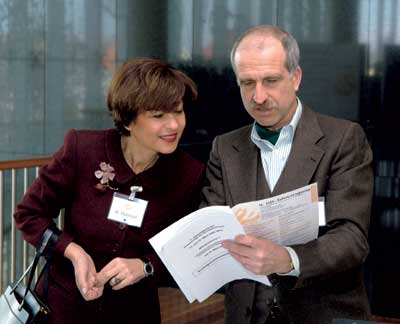 Dr. Erich Leitner in a discussion with a meeting participant has supported as one of the first Austrian GD members for a long time already the taking place of a GD Annual Meeting in Austria. In his function as director of the Gesellschaft Österreichischer Chemiker (Society of Austrian Chemists) he assisted the GD in her meeting organization. |
Beyond the PPAR in human sebocytes, additional related transcription factors were found, for example the liver-X-receptor and the Pregnan-X-receptor but not the Farnesoid-X-receptor. Therefore, further potential targets are feasible.
Penetration advancement
by Phloretine
The lecture series concerning pharmaceutical technology was opened by professor Dr. Claudia Valenta, Vienna, presenting phloretine contained in apples as possible penetration enhancer for dermally applied medicaments. First of all it had been checked whether the polyphenol interacts with membranes. As basic test system served dyed lipid vesicle at which known penetration enhancers trigger a color shift. In this uncomplex model for the stratum corneum phloretine also entailed a color shift.
In investigations with the differential scanning calometry phloretine shifts the transition temperature to lower values. Accordingly, the substance interacts not only with the membrane surface but also with the nucleus of the bi-layer. In test series at skin models the permeation of sodium fluoroescein and lidocain through the skin has been improved if these were impregnated 12 hours before by means of phloretine or the formulation itself contained the penetration enhancer. The penetration was however improved at a lesser degree than it had been expected owing to previous tests.
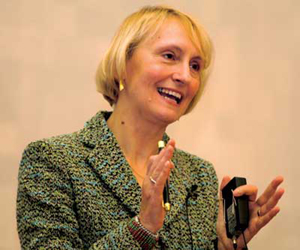 Professor Dr. Claudia Valenta from the Institut für Pharmazeutische Technologie und Biopharmazie of Vienna University (Institute for Pharmaceutical Technology and Biopharmacy) was active at 9th Annual Meeting of the Gesellschaft für Dermopharmazie as scientific conference head, moderator and lecturer. In her lecture she presented the polyphenol phloretine contained in apples as possible novel penetration enhancer for dermally applied medicaments. |
Increased bio-availability
by muco-adhesive carriers
Dr. Constantia Kritsch, Vienna, introduced the principle of muco-adhesion and a related concept for the drug application on the mucous membrane. Muco-adhesion is the ability of materials to adhere to mucous membranes. A tablet consisting of a muco-adhesive carrier should systematically release its drug by ionic interaction between the tablet and the mucous membrane and not to the environment. Moreover, it should adhere for a longer period of time to the mucous membrane thus allowing a retarded release of the active agent. The natural turnover of the mucous membrane limits however the application.
Kritsch implemented the concept with a chitosan-thioglycol-acid-conjugate which has been charged with clotrimazole to the vaginal antimycotics therapy. In-vitro tests with bovine vaginal mucous membrane confirmed the expected favourable adhesion, which obviously increases with the number of mercaptan groups of the polymer. Consequently the swell behaviour improves which is probably characterized by the formation of di-sulfid bridges within the polymer. In contrast to traditional tablets, breaking in the swelling process, the polymer expands and keeps its form. For the therapy of vaginal mycoses the concept promises an increased bio-availability of the drug and reduced therapy duration.
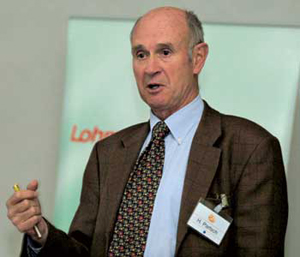 The well-known Vienna phlebologist professor Dr. Hugo Partsch informed in a noontime seminar about the phase-adjusted compression treatment of the Ulcus cruris venosum. Incited by the public relation work by the GD, this issue has also been dealt with by the media. The television station ORF produced an own report for its health broadcast "Modern Times Gesundheit" (Modern Times Health). |
Proof of free radicals in skin
A technological concept of quite a different nature has been presented by Dr. Thomas Herrling, Berlin, with the measurement of UV-induced free radicals in human skin. The particular benefit of this method based on electron spin resonance is the feasibility to realize free radicals in vivo directly in the skin and in real time. A substance has to be applied on the skin which intercepts the instable radicals and transforms them into more stable and detectable molecules.
The microwaves employed with wavelengths of 3 and 9.5 centimetres allow higher depths of penetration than conventional optical methods. Thus it could be realized for example that UVB light only penetrates in the epidermis, the longer-wave UVA-light however penetrates into the dermis, accordingly producing more free radicals.
Moreover, the procedure offers a potential for the optimization of anti-oxidative preparations and sun protection products. For instance it could be shown that highly effective anti-oxidants protect similarly well from free radicals as moderately potent UV-filters. At sole use the anti-oxidants do not come up to the protective effect of potent UV-filters.
Evidence also in cosmetology
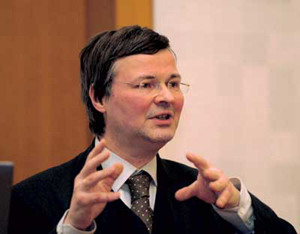 The GD vice president professor Dr. Hans Christian Korting from the Klinik and Poliklinik für Dermatologie und Allergologie of Ludwig-Maximilians- University Munich (Clinic and Polyclinic for Dermatology and Allergology) presented his concept of evidence-based cosmetology in a basic lecture. |
GD vice-president Professor Dr. Hans Christian Korting, Munich, pleaded for an application of the concept of evidence-based medicine (EBM) also in the sector of effectiveness proof tests for cosmetics in a basic lecture. In Korting's opinion it should be proven for a cosmetic with attributed active agent in at least one randomized controlled study at humans that the claimed effect of the product is greater compared to the corresponding formulation without active agent.
Tangible examples at which this concept had been successfully applied are already available. Korting mentioned a stabilized five-percent vitamin C cream for the improvement of the condition of light-damaged aged skin, a 40-percent urea preparation recommended for use at xeroxis of the foot soles, a two-percent coffein-liposome cream which proved to be effective at cellulite in contrast to the one-percent variant and a cream containing 0.25 percent of an extract from centella asiatica for the prevention of stretch marks.
At the same time the referee cleared out misapprehensions in the context of EBM. Although the suited use of the present state-of-the art is called for, the latter has to be made reference to for the respective individual problem. Controlled randomized clinical studies and meta-analyses are the favoured information sources of the EBM, though, in case no better information is on hand, also findings of lower evidence level are explicitly permissible.
Moreover, the fact is to be considered that the superiority of randomized clinical studies has to date not yet proven in a randomized investigation. "Evidence-based medicine is not evidence based", Korting concludes, at the same time he demands however to make use of the concept of EBM both for dermatological but also for cosmetological questions whenever possible and apply the results in practice.
Measurement of light-related
skin ageing
In the following lecture series dealing with Dermocosmetic issues, Dr. Paul-G. Sator, Vienna, introduced the possibility of objective characterization of light-related skin ageing by means of high-frequency ultrasound. 20 MHz ultrasound allows a recording of the skin condition to a penetration depth of 20 millimetres and skin ageing can be covered.
In an investigation comprising 124 persons - from which half of the patients were PUVA-treated psoriasis patients and the other half had healthy skin, the age-related diminishing of the skin thickness has been shown. Further, the skin at PUVA-treated patients was thinner depending on the dose than the one of non-treated persons of the same age. Moreover, it could be proven that women's skin is thinner than of men of the same age.
 All moderator tables at 9th GD Annual Meeting were interdisciplinarily taken. In this example with the pharmaceutical chemist private lecturer Dr. Oliver Werz (left), Frankfurt on the Main and the dermatologist professor Dr. Dr. Thomas Ruzicka, Düsseldorf. |
In the opinion of the referee, the practicable non-invasive method is qualified for the testing of effects resulting from a PUVA-therapy but also for the clarification of other questions in context with light-induced skin ageing.
Following Einstein's tracks
A lesser penetration depth, however an essentially higher resolution offers the optical coherence tomography. According to the explanations by private lecturer, Dr. Julia Welzel, Augsburg, the method is based on the Michelsen-Interferometry, which has incited Einstein to his special relativity theory. With a detection depth of up to one millimetre and a resolution of four micrometers, two-dimensional depth cut images are obtained, in which corneal, epidermal and dermal structures can be distinguished.
Welzel demonstrated the performance of the technique by means of various examples, in particular the progression control of wound healing. In addition, the method can be employed in the diagnostics of skin tumours as well as progression control of inflammatory skin diseases and quantification of therapy effects. Also the thickening of the horny layer by occlusion and atrophy after application of topical glucocorticoids are well ascertainable.
 Numerous specialized journalists participated in 9th GD Annual Meeting. The photograph shows Dr. Christiane Berg of the Pharmazeutische Zeitung (Pharmaceutical Journal) and Thomas Müller-Bohn concerned for Deutsche Apotheker Zeitung (German Pharmacist Journal) and DermoTopics. |
Concluding, the method of the optical coherence tomography is able to avail in objectifying research results and obtaining further information regarding the morphology of superficial skin components. Particular benefits are the non-invasive way of proceedings, the recording in real-time and minor efforts in comparison with histology.
 The dermatologist private lecturer, Dr. Julia Welzel, formerly employed with the Medizinische Universität (Medicinal University) Lübeck, presently employed with the Klinikum (Clinical Centre) Augsburg follows Einstein's tracks. She presented the bio-engineering procedure of the optical coherence tomography based on the Michelson-interferometry which has incited Einstein to its Special Relativity Theory. |
Wool wax allergies
often doubtful
Professor Dr. Werner Aberer, Graz calls for a more differentiated handling of the problem of wool wax allergies. Wool wax alcohols (lanolin) which are considered to be the contact-allergenic principle of wool wax are broadly applied in topical dermatics, cosmetics, household products and occupational substances.
The use of wool wax alcohols in every-day products is of particular significance, however, their relevance as contact allergen is considered controversially. The reputed American dermatologist Kligmann denies its sensitizing effect and designates the lanolin allergy as myth. On the other hand wool wax alcohols take a leading position in the allergy hit lists with sensitizing quota of about 4 percent.
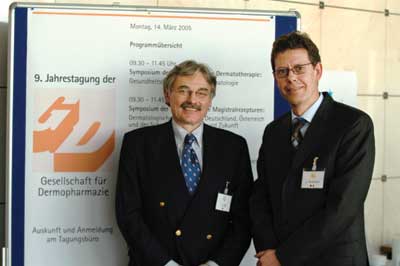 Professor Dr. Thomas Luger (left), in the photograph with GD president Dr. Joachim Kresken together with professor Dr. Klaus Müller is scientific head of the GD's 10th Annual Meeting which will take place on 4 and 5 April in Münster/Westphalia. |
Single positive test reactions on lanolin alcohols should accordingly be ensured by a practical test, before issuing uncritically an allergy pass for this widespread substance group implying all detrimental consequences for all concerned.
Anti-inflammatory effect
by Hyperforin
 At the GD's 9th Annual Meeting there was again sufficient opportunity for interdisciplinary and interprofessional interchange of ideas. An excellent occasion was the evening event organized by the GD which took place at Weinhaus Heuriger Reinprecht, Wien-Grinzing. |
Private lecturer Dr. Oliver Werz, Frankfurt on the Main opened the lecture series dealing with topics in the field of Dermatopharmacology and Dermatotherapy. He presented recent findings relating to the effective principle of anti-inflammatory properties of Hyperforin, an acyl phloroglucinol derivative from Hypericum perforatrum (Saint-John's- wort). Besides the established application as antidepressant Saint-John's-wort, preparations are also employed in skin care at inflammatory skin diseases, burns and poorly healing wounds. The molecular basis for the anti-inflammatory properties of Hyperforin is the inhibition of cyclooxy-genase- 1 (COX-1) and 5-lipoxygenase (5-LO). Hyperforin suppresses these two key enzymes involved in the arachidon-acid cascade in vivo and in vitro in relatively low concentrations. The COX-1-inhibition in human thrombocytes is for example three to 18 times more effective than the one of acetylsalicyl acid. COX-2 in contrast is not inhibited by Hyperforin.
Hyperforin possesses therapeutical potential as dual inhibitor of COX-1 and 5-LO both in intact cells and cell-free systems at inflammatory and allergenic diseases which are connected with eikosanoids.
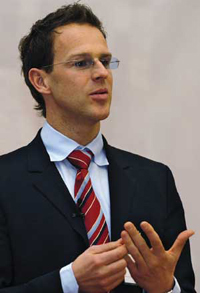 Private lecturer Dr. Oliver Werz from the Institut für Pharmazeutische Chemie (Institute for Pharmaceutical Chemistry) of Frankfurt University explained the principle of the anti-inflammatory effect of Hyperforin. |
Apoptosis by Imiquimod
Professor Dr. Eggert Stockfleth, Berlin, introduced with Imiquimod a substance which is already applied therapeutically for which however an additional mechanism of action is presumed. To date Imiquimod is authorized for the topical therapy of condyloma and superficial basalioma.
Imiquimod belongs to the immune stimulators of the type toll-like-receptor-7-agonist. It binds dendritic cells and mediates via the Th1-path an increased immunity towards viruses and tumours. By doing so, the innate and acquired immunity is combined.
Moreover, it could be shown, that Imiquimod induces apoptosis in human epithel cells and keratinocytes as well as in mice-fibroblasts. This is why also apoptotic processes could be responsible for the impact.
 Professor Dr. Eggert Stockfleth of Klinik für Dermatologie (Clinic for Dermatology) at University Clinical Center Charité in Berlin is leading author of the new guideline "Actinic Keratosis", which has been elaborated in cooperation with the Gesellschaft für Dermopharmazie (please refer to report on page 8). At the GD's 9th Annual Meeting he informed about latest findings referring to the active principle of the local immune stimulator Imiquimod. |
Nuclear hormone receptors
as therapeutical targets
Professor Dr. Matthias Schmuth, Innsbruck, presented the perspectives of nuclear hormone receptors as therapeutical target structures in the course of the last lecture of the meeting. Nuclear hormone receptors encompass besides the classical glucocorticoid-, mineralcorticoid-, oestrogen-, progesterone and androgen-receptors also the retinoid-receptors, the vitamin-D-receptor, liver X-receptors (LXR) already known from Dermatotherapy and peroxisome-proliferator-activated receptors (PPAR) addressed in Chen's lecture (see above).
Before nuclear hormone receptors are able to perform their effect, they have to be activated by special ligands. Following, they modulate the activity of genes in the cell nucleus. They take effect on key genes of the signal transduction, proliferation, differentiation, apoptosis and inflammation. In view of the therapeutical success achieved with the receptors already known for some time now, LXR and PPAR - which have become known only recently - arouse expectations regarding their potential for medicinal uses.
Different from classical hormone receptors LXR and PPAR are in many cases activated by lipophilic substances without steroid structure. It is supposed that each receptor regulates distinct signal transduction paths and the direction of the regulation may additionally be controlled by the selection of the ligand. Accordingly, the diverse receptors are distinguished by differential active profiles which could possibly be made utilizable for dermatological therapy.
Outlook for the
GD's 10th Annual Meeting
 In conclusion of the scientific main program Professor Dr. Matthias Schmuth of the Hautklinik of the Medizinische Universität Innsbruck (Dermatological Clinic of the Medicinal University) broached the issue of novel activators for nuclear hormone receptors and their perspective in dermatological therapy. |
Vice-president professor Hans Christian Korting, Munich, outlined in his recapitulatory summary, that the scientific main program of the GD's 9th Annual Meeting offered besides some at present already practically applied aspects in the first place insights in expected possibilities of Dermatotherapy and Dermocosmetic of tomorrow. In which way remarkable effects can already be achieved today and the problems to be solved in doing so has been dealt with in concomitant symposia and noontime seminars of the meeting.
The 10th Annual Meeting of the Gesellschaft für Dermopharmazie will inform about further progress in various fields of Dermopharmacy. It will take place on 4 and 5 April 2006 in Münster/Westphalia. Scientific conference heads will be the director of the University Dermatological Clinic and secretary general of the Deutsche Dermatologische Gesellschaft (German Dermatological Society), professor Dr. Thomas Luger as well as professor Dr. Klaus Müller from the Institut für Pharmazeutische Chemie (Institute for Pharmaceutical Chemistry) of Münster University.
|
Sponsors of the Annual Meeting |
top
